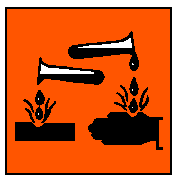International Chemical Safety Cards
| CHLOROACETYL CHLORIDE | ICSC: 0845 |
CHLOROACETYL CHLORIDE |
 |
| TYPES OF HAZARD/ EXPOSURE |
ACUTE HAZARDS/ SYMPTOMS |
PREVENTION | FIRST AID/ FIRE FIGHTING |
| FIRE | Not combustible. Gives off
irritating or toxic fumes (or gases) in a fire. |
|
Powder, carbon dioxide. |
| EXPLOSION | |
|
|
| EXPOSURE | |
AVOID ALL CONTACT! |
|
| INHALATION | Burning sensation. Cough.
Laboured breathing. Symptoms may be delayed (see Notes). |
Ventilation, local exhaust, or
breathing protection. |
Fresh air, rest. Half-upright
position. Refer for medical attention. |
| SKIN | Redness. Serious skin burns.
Pain. |
Protective clothing. |
Remove contaminated clothes.
Rinse skin with plenty of water or shower. Refer for medical attention. |
| EYES | Redness. Pain. Blurred vision.
Severe deep burns. |
Face shield, or eye protection
in combination with breathing protection. |
First rinse with plenty of water
for several minutes (remove contact lenses if easily possible), then take to a doctor. |
| INGESTION | Abdominal pain. Burning
sensation. Diarrhoea. Vomiting. |
Do not eat, drink, or smoke
during work. |
Do NOT induce vomiting. Give
nothing to drink. Refer for medical attention. |
| SPILLAGE DISPOSAL | STORAGE | PACKAGING & LABELLING | ||
| Collect leaking and spilled
liquid in sealable containers as far as possible. Then remove to safe place. (extra
personal protection: complete protective clothing including self-contained breathing
apparatus). |
Separated from food and
feedstuffs. Cool. Keep in a well-ventilated room. |
Airtight. Do not transport with
food and feedstuffs. C symbol R: 34-37 S: 9-26 UN Hazard Class: 8 UN Packing Group: II |
||
| SEE IMPORTANT INFORMATION ON BACK | ||||
|
||||